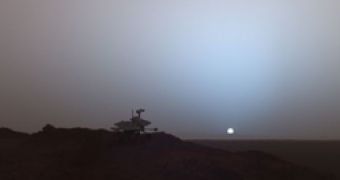After comet Holmes displayed a fantastic show on 23rd of October this year (when it suddenly presented its second outburst in recorded history multiplying its brightness close to a million times more than usual, only to later become the largest object in the solar system) and the Leonid meteor shower last week-end, Mars is now claiming its part of attention, by increasing its brightness about two times more than usual.
According to amateur astronomer Friedrich Deters of LaGrange, North Caroline, who took a picture of the Red Planet, on 17th of November and Dan Peterson of Racine, Wisconsin, who captured a similar image in the following night, Earth's sister is looking very good this time of the year.
Traveling on the trajectory that takes it around the Sun, Mars is now exposing its north pole to the sunlight, thus evaporating part of the ice trapped on its surface, creating large clouds of icy blue gas, swirling around over the north pole region, during winter. The blue color effect is created by the sunlight being filtered and reflected through the extremely thin ice crystals that could be smaller in size than the wavelength of the light coming from the Sun, levitating in the cloud. The contrast created by the blue cap over the red Martian soil can be visible from Earth with the help of a mid-sized telescope.
The Red Planet can be viewed amongst the stars of the Gemini constellation, on the night sky, as a bright red dot, clearly visible with the naked eye.
Astronomers say that the planet will be easily visible on 26th and 27th of November, when the full Moon will glide past Mars only a degree away, the combination of the two objects close together on the night sky, should be enough to draw attention. On Monday it will be visible to the east side of the Moon, right before bedtime and during the following morning to the west.
The reason for the increased brightness is due to the fact that Earth and Mars are drawn closer together, while speeding on their way around the Sun. On 18th of December, the twin planets will lie at a distance of only 34.3 million kilometers from one another. Though this might seem as a large distance, on the scale of the solar system it is quite small. The different space agencies are taking advantage of this close encounter with the Red Planet to send new missions to Mars, such as NASA's Phoenix Lander, which will join the other fleet of land rover driving along the Martian soil, in an effort to replace the Spirit and Opportunity land rovers which have suffered a series of mechanical failures due to their advanced age.
The Phoenix mission was launched in August this year and is scheduled to reach the Red Planet in May next year.

 14 DAY TRIAL //
14 DAY TRIAL // 
